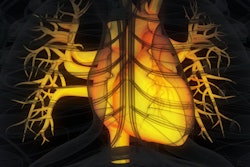
A significant proportion of coronary CT angiography (CCTA) scans has been deemed ineligible for analysis with fractional flow reserve CT (FFR-CT) in recent studies. An international team of researchers investigated the underlying causes behind this issue in an article published online July 23 in Radiology.
FFR-CT enables clinicians to calculate fluid dynamics within the heart as a possible indicator of coronary artery disease (CAD). The technique is far less invasive than conventional FFR, in which a guidewire is threaded via a catheter into a coronary artery to measure blood pressure and flow.
Prior research has demonstrated numerous advantages of integrating FFR-CT into the assessment of CAD, including improved diagnostic accuracy and risk prediction. More specifically, FFR-CT can help reduce the number of patients unnecessarily referred for invasive coronary angiography, noted co-first authors Drs. Gianluca Pontone, PhD, from Centro Cardiologico Monzino in Italy and Jonathan Weir-McCall of the University of Cambridge in the U.K. and colleagues.
But CCTA images must be of adequate quality to be analyzed with FFR-CT software -- and many images are falling short. For instance, as much as 33% of CCTA scans in the Prospective Multicenter Imaging Study for Evaluation of Chest Pain (PROMISE) trial were ineligible for FFR-CT analysis, prompting concern among clinicians.
To better understand this setback, Pontone, Weir-McCall, and colleagues acquired CCTA scans of 2,778 patients as part of the Assessing Diagnostic Value of Noninvasive FFR-CT in Coronary Care (ADVANCE) registry. They also obtained the CCTA scans of 10,416 cases that were submitted for FFR-CT analysis at one of 76 distinct medical centers across the globe. The researchers searched for the chief factors contributing to the rejection of CCTA scans for FFR-CT analysis in these two groups of patients.
In total, the researchers noted an FFR-CT rejection rate of 2.9% in the ADVANCE registry and 8.6% for the clinical cohort. They found that the main reason for the rejection of CCTA scans was inadequate image quality, primarily due to motion artifacts, which were present in 78% of the CCTA scans in the ADVANCE registry and 64% in the clinical cohort.
Through multivariable analysis, the researchers additionally uncovered several factors that were independent predictors of FFR-CT rejection: CCTA scans with a relatively large temporal resolution and slice thickness, as well as scans of patients with a relatively fast heart rate.
| Factors affecting eligibility of CCTA scans for FFR-CT analysis | ||||
| Eligible for FFR-CT | Ineligible for FFR-CT | |||
| ADVANCE registry | Clinical cohort | ADVANCE registry | Clinical cohort | |
| CCTA slice thickness | 0.64 mm | 0.63 mm | 0.67 mm | 0.65 mm |
| CCTA temporal resolution | 106 msec | 119 msec | 119 msec | 130 msec |
| Patient heart rate | 60 beats per minute | 60 beats per minute | 63 beats per minute | 65 beats per minute |
Furthermore, the researchers found that the increased use of dual-source CT scanners and wide-coverage single-source CT scanners was associated with fewer rejected CCTA scans. Clinicians used these technologies for roughly 85% of CCTA exams in the ADVANCE registry and 79% in the clinical cohort, compared with only 17% in the PROMISE study.
The findings suggest that clinicians should be able to use nearly all CCTA scans for FFR-CT analysis with simple adjustments to scanning protocols, such as minimizing image slice thickness, controlling patient heart rate, and using dual-source or wide-coverage single-source CT scanners.
"Although a certain degree of [selection] bias may not be excluded, the low rejection rate of FFR-CT in the control cohort is encouraging for widespread use of FFR-CT in patients with CAD," Dr. Hajime Sakuma, PhD, of Mie University Hospital in Japan wrote in an accompanying editorial.




















